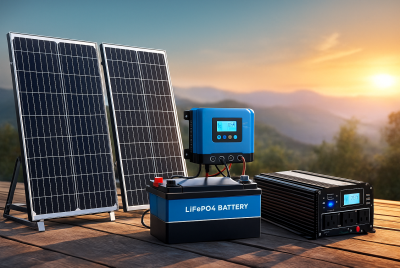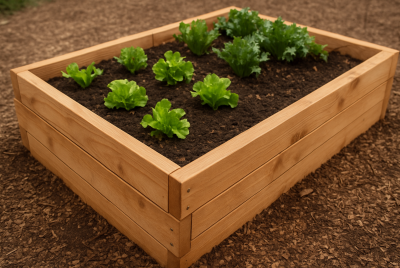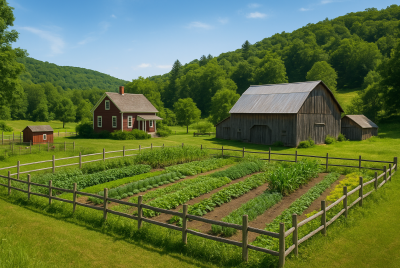DIY Solar Water Heater: 5 Warm-Water Designs for Homestead Use
We may earn a commission for purchases made using our links. Please see our disclosure to learn more.
If you’re building a homestead and want a dependable source of warm water, a DIY solar water heater is one of the smartest upgrades you can make. It lowers your energy use, works with simple materials, and delivers steady warm water using nothing but sunlight. Because these systems rely on straightforward designs and basic heat transfer, you can build one in a weekend and keep it running with minimal upkeep.
What Makes a DIY Solar Water Heater Worth Building?
Warm water may not seem like a major luxury until you try living without it for a season. Homesteaders know this feeling well. When you generate everything yourself, even a few gallons of hot water can change the rhythm of your day.
A DIY solar water heater offers several benefits:
- It uses free, renewable sunlight.
- It cuts your electricity or propane use.
- It requires minimal ongoing maintenance.
- It’s reliable even in remote areas.
- It works for showers, dishes, and livestock use.
Most homesteaders also appreciate that solar water heaters can be scaled. You can start with a simple hose-coil heater and expand toward a more advanced panel-and-pump system over time. With thoughtful planning, your water heater becomes a long-term energy asset.
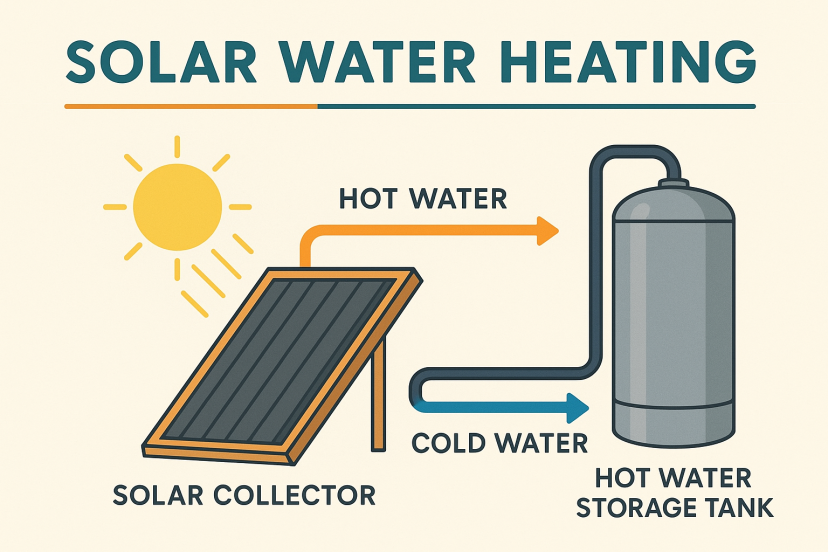
How Does Solar Water Heating Work?
Every solar water heater follows the same basic idea: sunlight hits a dark surface, the surface heats up, and that heat transfers into water. After that point, the water either moves by gravity (passive flow) or through pumps (active flow).
Here’s how the two main categories work:
Passive Systems
These rely on thermosiphon—a natural process where hot water rises and cold water sinks. No pumps, no electricity. They’re great for homesteads that prioritize simplicity and low-tech reliability.
Active Systems
These use small pumps to circulate water through panels. They heat water faster and perform better in cooler climates.
Both options will work on most properties. Your final choice depends on climate, water needs, and how hands-on you want to be with installation.
5 DIY Solar Water Heater Designs for Homestead Use
Below are five designs that balance affordability, performance, and ease of construction. Many homesteaders start with one model, learn the basics, and then upgrade to a more advanced system.
1. Black Hose Coil Heater (Easiest for Beginners)
The black-hose method is the classic weekend project. It heats water fast on sunny days and costs very little.
How it works:
You coil a long black irrigation hose on a board or inside a shallow box. The hose absorbs heat and warms the water inside as it runs through.
What you’ll like:
- Extremely budget-friendly
- No pump required
- Perfect for outdoor showers or livestock use
You’ll need:
A flat board, a black hose, zip ties, and optionally a clear cover to trap heat.
Best climates:
Warm, sunny regions where daytime temperatures stay above 65°F.
2. Batch Water Heater (Breadbox Style)
A batch heater combines a water tank and a mini solar collector into one box. It’s more efficient than the hose-coil design because the insulated box traps heat.
How it works:
You place a dark-painted water tank inside an insulated box with a glass or clear-plastic front. Sunlight heats the tank, and insulation keeps the heat inside.
What you’ll like:
- Steady warm water
- More durable than hose coils
- Excellent for non-freezing climates
Best climates:
Mild areas where the tank won’t freeze at night.
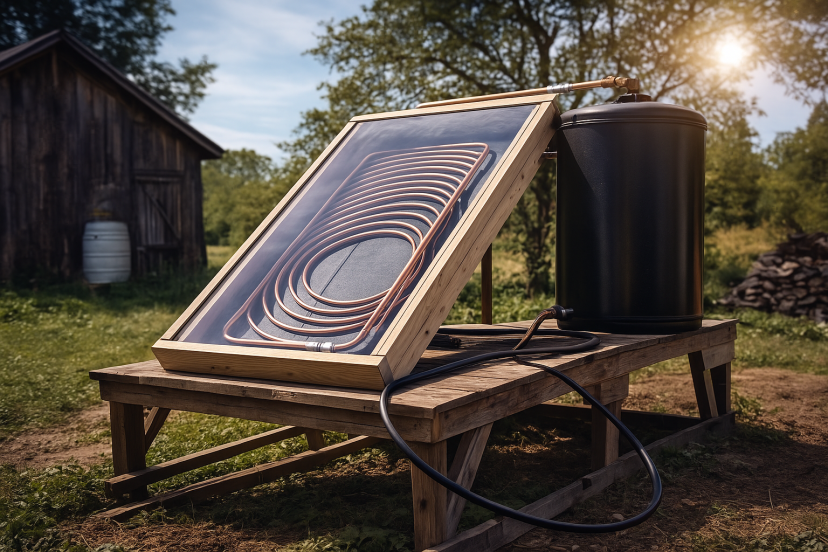
3. Solar Collector With Copper Tubing
This design is ideal if you want reliable hot water for regular household use. Copper transfers heat quickly, so this model works well even during cooler months.
How it works:
Soft copper tubing is shaped into a tight coil attached to a black absorber plate. You cover the collector with tempered glass. Cool water goes in, absorbs heat inside the system, and comes out noticeably warmer.
What you’ll like:
- Higher heat output
- Long-lasting materials
- Works for both off-grid sinks and showers
Best climates:
Anywhere with solid sunshine, including cooler homestead zones.
4. Thermosiphon Water Heater (Passive Hot-Water Flow)
A thermosiphon system is one of the smartest designs for low-tech living. Once you install it, it heats and circulates water automatically.
How it works:
Cold water flows downward through the collector. As it heats, it naturally rises into a storage tank placed above the panel. No pump required.
What you’ll like:
- Fully passive system
- Reliable for daily use
- Very efficient in warm regions
Best climates:
Warm to hot climates where freeze protection isn’t needed.
5. Solar Water Heating Panel + Pump Kit (Hybrid System)
This hybrid model works like the collector-and-copper setup, but the pump helps move water even when temperatures fluctuate. It’s great for homesteads that want consistent performance.
How it works:
A pump circulates water through solar heating panels. The water flows into an insulated tank where warm water is stored.
What you’ll like:
- Strong performance in variable climates
- Good for small families
- Can pair with photovoltaic solar panels
Best climates:
All climates, especially those with mixed seasonal temperatures.
Top Products to Support Your DIY Solar Heater
Here are five reliable tools and materials that homesteaders often use:
- SunHeater Black Polyethylene Solar Heating Hose
Long, UV-resistant, and ideal for coil setups. - Klein Tools IR1 Infrared Thermometer
Helps measure collector temperature during testing. - ACOPOWER 12V Pump Kit
A compact pump perfect for hybrid solar water heating systems. - Tempered Glass Sheet
Weather-resistant and ideal for enclosed solar collectors. - Gorilla Waterproof Patch & Seal Tape
A heavy-duty option for sealing joints and preventing minor leaks.
What Research Shows About Solar Water Heating Performance
Solar water heating isn’t just a clever homestead hack—there’s strong research showing why these systems work so well. One widely cited review by Kalogirou (published in Progress in Energy and Combustion Science) breaks down how different types of solar collectors perform, especially for low-temperature uses like domestic hot water. The findings show that simple designs—such as flat-plate collectors and evacuated tubes—deliver consistent, dependable heat when paired with good insulation and proper orientation. Those insights closely parallel the logic behind DIY collectors, where dark absorber surfaces and enclosed panels help trap and retain heat efficiently.
A more recent comprehensive review published in 2024 by Eze and colleagues (SpringerOpen) reinforces this. The authors analyzed multiple case studies and found that solar water heaters can dramatically cut household energy use and reduce emissions. Their work also highlights how design choices—like storage tank size, insulation quality, and collector area—strongly influence performance. Interestingly, the review notes that even passive systems, including batch heaters and thermosiphon setups, can achieve stable, year-round operation with minimal maintenance when sized correctly.
These studies support what many homesteaders already experience firsthand: solar water heating works reliably, scales easily, and continues performing well season after season with only basic upkeep.
Choosing Which Solar Water Heater to Build
Because every homestead is different, it helps to consider:
Your Climate
- Hot climates: Hose-coil or thermosiphon systems work extremely well.
- Mild climates: Batch heaters strike a balance between simplicity and performance.
- Cooler climates: Copper-coil or hybrid systems with pumps perform best.
Your Water Needs
Small cabins might only need a hose-coil shower. Larger households may want a hybrid system.
Your Budget
A starter build can cost $50. A more advanced system may cost a few hundred.
Safety Tips for DIY Solar Water Heating Systems
- Avoid sealing water in a closed system, as pressure can build.
- Place storage tanks securely to prevent tipping.
- Wrap any pipes that sit out in the open so they hold onto heat more effectively.
- Check fittings for leaks after installation.
- Don’t place glass surfaces where falling branches can reach them.
Conclusion
Building a DIY solar water heater is one of the most rewarding homestead projects you can take on. It saves you money, simplifies your energy needs, and provides warm water with nothing but sunshine. Whether you choose a simple hose coil or a full panel-and-pump system, each design moves you closer to a more sustainable, self-reliant lifestyle. And once you combine your heater with broader renewable power planning, your homestead becomes even more resilient.
FAQs
1. How hot can a DIY solar water heater get?
On sunny days, many designs can heat water to 100–140°F depending on the system.
2. How much time will you need to put a system together?
Some setups take an afternoon. Others may require a full weekend.
3. Is a solar water heater still useful during the colder months?
Yes, especially copper-tube and hybrid systems. You may need freeze protection.
4. Do I need special tools?
Most builds require only basic tools like drills, wrenches, and sealant.
5. Is a DIY heater safe for indoor plumbing?
Yes, if you use heat-resistant piping and follow standard plumbing safety practices.


